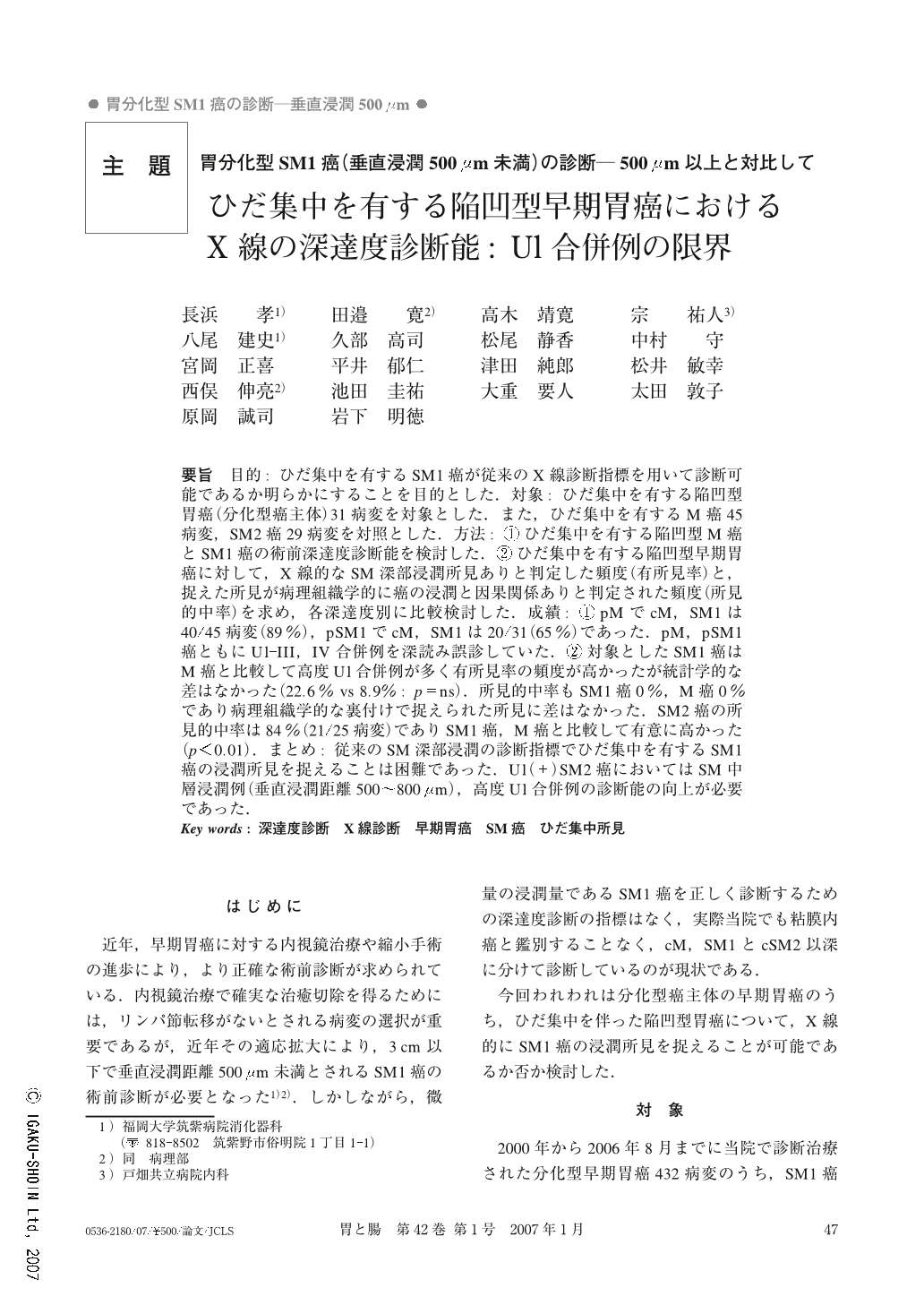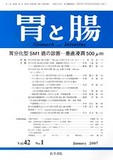Japanese
English
- 有料閲覧
- Abstract 文献概要
- 1ページ目 Look Inside
- 参考文献 Reference
- サイト内被引用 Cited by
要旨 目的:ひだ集中を有するSM1癌が従来のX線診断指標を用いて診断可能であるか明らかにすることを目的とした.対象:ひだ集中を有する陥凹型胃癌(分化型癌主体)31病変を対象とした.また,ひだ集中を有するM癌45病変,SM2癌29病変を対照とした.方法:①ひだ集中を有する陥凹型M癌とSM1癌の術前深達度診断能を検討した.②ひだ集中を有する陥凹型早期胃癌に対して,X線的なSM深部浸潤所見ありと判定した頻度(有所見率)と,捉えた所見が病理組織学的に癌の浸潤と因果関係ありと判定された頻度(所見的中率)を求め,各深達度別に比較検討した.成績:①pMでcM,SM1は40/45病変(89%),pSM1でcM,SM1は20/31(65%)であった.pM,pSM1癌ともにUl-III,IV合併例を深読み誤診していた.②対象としたSM1癌はM癌と比較して高度Ul合併例が多く有所見率の頻度が高かったが統計学的な差はなかった(22.6% vs 8.9%:p=ns).所見的中率もSM1癌0%,M癌0%であり病理組織学的な裏付けで捉えられた所見に差はなかった.SM2癌の所見的中率は84%(21/25病変)でありSM1癌,M癌と比較して有意に高かった(p<0.01).まとめ:従来のSM深部浸潤の診断指標でひだ集中を有するSM1癌の浸潤所見を捉えることは困難であった.Ul(+)SM2癌においてはSM中層浸潤例(垂直浸潤距離500~800μm),高度Ul合併例の診断能の向上が必要であった.
Objective : The aim of this report is to elucidate the precision with which submucosal (SM) 1 carcinoma with convergence of the mucosal folds, can be diagnosed using conventional radiologic indicators for diagnosis. Subjects : The subjects were 31 lesions of depressed gastric cancer (mainly of the differentiated type) with convergence of the mucosal folds. Forty-five lesions of mucosal (M) carcinoma with convergence of the mucosal folds and 29 lesions of SM2 carcinoma served as controls. Methods : (1) The accuracy of preoperative X-ray was investigated for estimating the depth of depressed M carcinoma and SM1 carcinoma lesions with convergence of the mucosal folds. (2) The frequency of finding a positive X-ray indicator of deep SM infiltration in the cases of depressed early gastric cancer with convergence of the mucosal folds (the radiological positivity rate) and the frequency with which the observed radiological findings could be confirmed by histopathological examination as being causally related to the cancer infiltration (the accuracy rate) were determined, and then investigated comparatively according to the depth of invasion. Results : (1) Forty (89%) of the 45 pM lesions showed cM, SM1, and 20 (65%) of the 31 pSM1 lesions showed cM, SM1. The assessment of factors giving rise to errors in the diagnosis revealed that both pM and pSM1 carcinomas were overdiagnosed in cases with ulcer formation (Ul)-III and IV, with a reduced accuracy of diagnosis. (2) The radiologic positivity rate was higher for SM1 lesions than for M carcinoma lesions, but the difference was not statistically significant difference (22.6% vs. 8.9% ; p=ns). The diagnostic accuracy rate of the findings was 0% for SM1 carcinoma lesions and 0% for M carcinoma lesions, the difference not being significant. The diagnostic accuracy rate of the radiologic findings in SM2 or deeper carcinoma lesions was 84% (21/25 lesions), which was significantly (p<0.01) higher than that for the SM1 and M carcinoma lesions. Conclusions : All of the above-described observations indicate that it is difficult to make a diagnosis of pSM1 carcinoma lesions with convergence of mucosal folds from conventional radiologic indicators for the diagnosis of SM carcinomas showing deep infiltration. It was, therefore, concluded that improvements in imaging and diagnostic techniques are needed, particularly for lesions with vertical distance of infiltration of 500~800μm and those classified as Ul-III and IV.

Copyright © 2007, Igaku-Shoin Ltd. All rights reserved.


